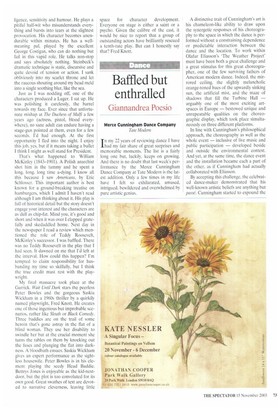Baffled but enthralled
Giannandrea Poesio
Merce Cunningham Dance Company Tate Modem Inmy 22 years of reviewing dance I have had my fair share of great surprises and memorable moments. The list is a fairly long one but, luckily, keeps on growing. And there is no doubt that last week's performance by the Merce Cunningham Dance Company at Tate Modern is the latest addition. Only a few times in my life have I felt so exhilarated, amused, intrigued, bewildered and overwhelmed by pure artistic genius.
A distinctive trait of Cunningham's art is his chameleon-like ability to draw upon the synergetic responses of his choreography to the space in which the dance is performed without a constraining dependence or predictable interaction between the dance and the location. To work within Olafur Eliasson's The Weather Project' must have been both a great challenge and a great stimulus for this great choreographer, one of the few surviving fathers of American modern dance. Indeed, the mirrored ceiling, the slightly melancholic orange-toned hues of the upwardly sinking sun, the artificial mist, and the maze of shadows that fill the Turbine Hall — arguably one of the most exciting artspaces in Europe — bestowed unique and unrepeatable qualities on the choreographic display, which took place simultaneously on three different platforms.
In line with Cunningham's philosophical approach, the choreography as well as the whole event — inclusive of live music and public participation — developed beside and outside the environmental context. And yet, at the same time, the dance event and the installation became each a part of the other, as if Cunningham had actually collaborated with Fliasson.
By accepting this challenge, the celebrated dance-maker demonstrated that his well-known artistic beliefs are anything but passe. Cunningham started to expound the principles of a revolutionary approach to choreography, and to modem dance in particular, almost half a century ago. Thanks to his close collaboration with the composer John Cage, he subverted many of the tenets of what was then regarded as contemporary or 'modern' dance. The philosophy behind his work, derived from a combination of Eastern and Western thought, undermined the conventions of dance performance long before 'postmodern' artists such as Yvonne Rainer, Simone Forti and Trisha Brown hit the international scene with their own revolutionary ideas.
Cunningham's theories were soon imported to Europe, where they complemented the budding avant-garde movement that challenged, from the early 1960s onwards, the theatre scene of the old world. Yet, while that avant-garde is now long past its sell-by date, Cunningham's canons are still as provocatively fresh as any of the more up-to-date performancerelated experimentations. To walk between one platform and another, to interact with other members of the public who moved from one side to the other of the Turbine Hall to catch fragmented glimpses of the ongoing action, to lie and stretch over the floor of the Hall to admire the whole event reflected in the suspended mirrors, thus realising that the dancers moving on and from one platform to another were, in the end, similar to the non-dancers who performed similar movements, was hardly something new. And yet it came across as an intense, never-beforeexperienced theatre happening.
It would be a mistake, however, not to stress the impact of the dancing, which was the central magic-weaving catalyst of the entire event. Those who are familiar with Cunningham's work might have recognised the provenance of some of the movements performed by the splendid interpreters. Yet the 'Spotting Game' is totally unnecessary on such occasions, for what counts is the way that the diverse movement ideas complemented and fed into each other, even though there were no apparent links between what happened on each of the three platforms.
Following a secret code, the dancers moved quickly from one performance space to another, and then engaged in a series of movements that encompassed the whole Cunningham style and technique. But they also stretched, stopped for a sip of water, squatted, or ran from one platform to another, following well-marked paths no one from the public could trespass on to. Whatever they did, they never stopped performing, thus providing the viewer with a unique richness of dance material. The performance — one of the events celebrating the Cunningham company's 50th anniversary — concluded the 25th Dance Umbrella Festival. May this world-renowned dance festival live for ever!



























































































 Previous page
Previous page